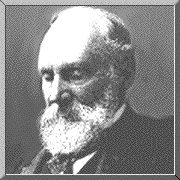 William
Thomson Kelvin was born on June 26, 1824 in Belfast
Ireland. He attended Cambridge and Glasgow Universities. In 1846 he
accepted a position as a professor at the University of Glasgow.
William
Thomson Kelvin was born on June 26, 1824 in Belfast
Ireland. He attended Cambridge and Glasgow Universities. In 1846 he
accepted a position as a professor at the University of Glasgow.
Kelvin is remembered for his work in thermodynamics. He and James Joule investigated the relationship between mechanical energy and heat, their work resulted in the Joule-Thomson cooling effect. He also developed a temperature scale that is known as the Kelvin scale. Kelvin also investigated the oscillating nature of electrical discharges. He contributed to our understanding of the theory of elasticity, the electrodynamic properties of metals, and magnetism. Working with others, he estimated the age of the sun and computed the energy radiated from it.
In terms of inventions, Kelvin assisted with the laying of the Atlantic telegraph cable, the mirror galvanometer, the tide predictor, a mariner's compass, a depth sounder, and the siphon recorder.
His writings include Papers on Electricity and Magnetism (1872), Mathematical and Physical Papers (1882, 1883, 1890). For his work he was knighted in 1866, selected as President of the Royal Society, and received the Order of Merit (1902). Edmund Kelvin died on December 17, 1907.
References
Debus, A.G. (1968). World Who's Who in Science: A Biographical Dictionary of Notable Scientists from Antiquity to the Present. Chicago: Marquis.
Howard, A.V. (1951). Chamber's Dictionary of Scientists. London: Chambers.
McGraw-Hill (1966). McGraw-Hill Modern Men of Science. New York: McGraw Hill.
Struik, D.J. (1987). A Concise History of Mathematics. New York: Dover Publications.
Taton, R. (Ed.) (1963). History of Science: Ancient and Medieval Science from the Beginnings to 1450. New York: Basic Books.